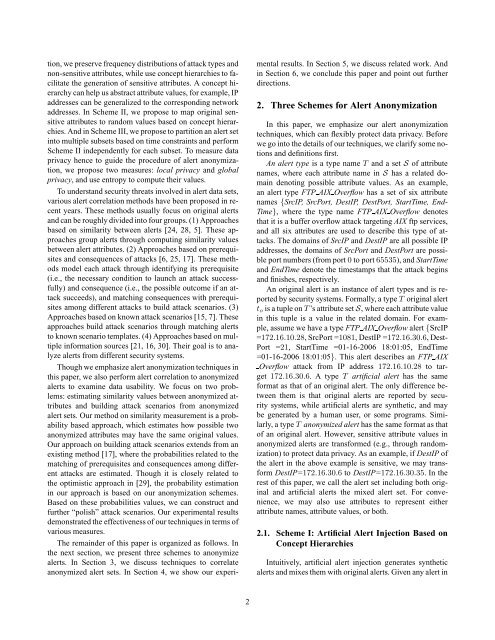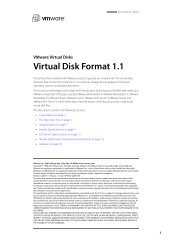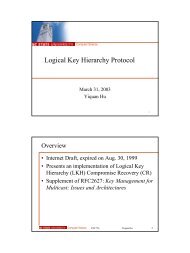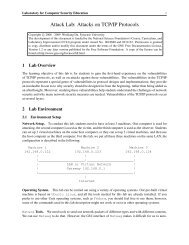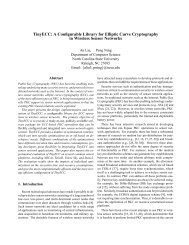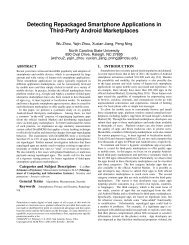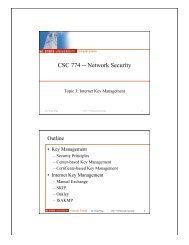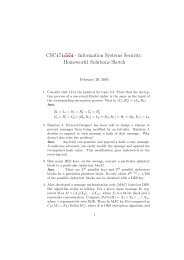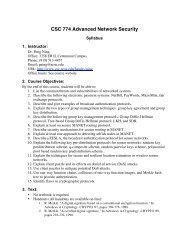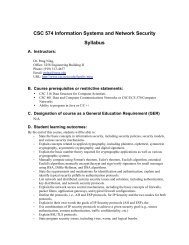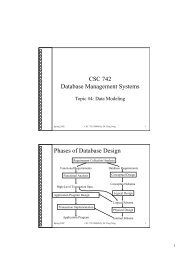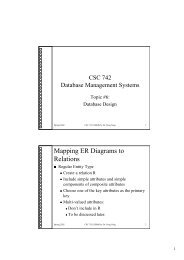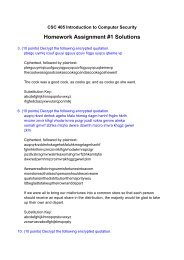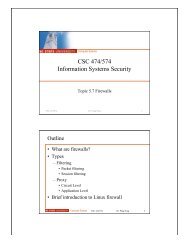A Flexible Approach to Intrusion Alert Anonymization and Correlation
A Flexible Approach to Intrusion Alert Anonymization and Correlation
A Flexible Approach to Intrusion Alert Anonymization and Correlation
Create successful ePaper yourself
Turn your PDF publications into a flip-book with our unique Google optimized e-Paper software.
tion, we preserve frequency distributions of attack types <strong>and</strong><br />
non-sensitive attributes, while use concept hierarchies <strong>to</strong> facilitate<br />
the generation of sensitive attributes. A concept hierarchy<br />
can help us abstract attribute values, for example, IP<br />
addresses can be generalized <strong>to</strong> the corresponding network<br />
addresses. In Scheme II, we propose <strong>to</strong> map original sensitive<br />
attributes <strong>to</strong> r<strong>and</strong>om values based on concept hierarchies.<br />
And in Scheme III, we propose <strong>to</strong> partition an alert set<br />
in<strong>to</strong> multiple subsets based on time constraints <strong>and</strong> perform<br />
Scheme II independently for each subset. To measure data<br />
privacy hence <strong>to</strong> guide the procedure of alert anonymization,<br />
we propose two measures: local privacy <strong>and</strong> global<br />
privacy, <strong>and</strong> use entropy <strong>to</strong> compute their values.<br />
To underst<strong>and</strong> security threats involved in alert data sets,<br />
various alert correlation methods have been proposed in recent<br />
years. These methods usually focus on original alerts<br />
<strong>and</strong> can be roughly divided in<strong>to</strong> four groups. (1) <strong>Approach</strong>es<br />
based on similarity between alerts [24, 28, 5]. These approaches<br />
group alerts through computing similarity values<br />
between alert attributes. (2) <strong>Approach</strong>es based on prerequisites<br />
<strong>and</strong> consequences of attacks [6, 25, 17]. These methods<br />
model each attack through identifying its prerequisite<br />
(i.e., the necessary condition <strong>to</strong> launch an attack successfully)<br />
<strong>and</strong> consequence (i.e., the possible outcome if an attack<br />
succeeds), <strong>and</strong> matching consequences with prerequisites<br />
among different attacks <strong>to</strong> build attack scenarios. (3)<br />
<strong>Approach</strong>es based on known attack scenarios [15, 7]. These<br />
approaches build attack scenarios through matching alerts<br />
<strong>to</strong> known scenario templates. (4) <strong>Approach</strong>es based on multiple<br />
information sources [21, 16, 30]. Their goal is <strong>to</strong> analyze<br />
alerts from different security systems.<br />
Though we emphasize alert anonymization techniques in<br />
this paper, we also perform alert correlation <strong>to</strong> anonymized<br />
alerts <strong>to</strong> examine data usability. We focus on two problems:<br />
estimating similarity values between anonymized attributes<br />
<strong>and</strong> building attack scenarios from anonymized<br />
alert sets. Our method on similarity measurement is a probability<br />
based approach, which estimates how possible two<br />
anonymized attributes may have the same original values.<br />
Our approach on building attack scenarios extends from an<br />
existing method [17], where the probabilities related <strong>to</strong> the<br />
matching of prerequisites <strong>and</strong> consequences among different<br />
attacks are estimated. Though it is closely related <strong>to</strong><br />
the optimistic approach in [29], the probability estimation<br />
in our approach is based on our anonymization schemes.<br />
Based on these probabilities values, we can construct <strong>and</strong><br />
further “polish” attack scenarios. Our experimental results<br />
demonstrated the effectiveness of our techniques in terms of<br />
various measures.<br />
The remainder of this paper is organized as follows. In<br />
the next section, we present three schemes <strong>to</strong> anonymize<br />
alerts. In Section 3, we discuss techniques <strong>to</strong> correlate<br />
anonymized alert sets. In Section 4, we show our experimental<br />
results. In Section 5, we discuss related work. And<br />
in Section 6, we conclude this paper <strong>and</strong> point out further<br />
directions.<br />
2. Three Schemes for <strong>Alert</strong> <strong>Anonymization</strong><br />
In this paper, we emphasize our alert anonymization<br />
techniques, which can flexibly protect data privacy. Before<br />
we go in<strong>to</strong> the details of our techniques, we clarify some notions<br />
<strong>and</strong> definitions first.<br />
An alert type is a type name T <strong>and</strong> a set S of attribute<br />
names, where each attribute name in S has a related domain<br />
denoting possible attribute values. As an example,<br />
an alert type FTP AIX Overflow has a set of six attribute<br />
names {SrcIP, SrcPort, DestIP, DestPort, StartTime, End-<br />
Time}, where the type name FTP AIX Overflow denotes<br />
that it is a buffer overflow attack targeting AIX ftp services,<br />
<strong>and</strong> all six attributes are used <strong>to</strong> describe this type of attacks.<br />
The domains of SrcIP <strong>and</strong> DestIP are all possible IP<br />
addresses, the domains of SrcPort <strong>and</strong> DestPort are possible<br />
port numbers (from port 0 <strong>to</strong> port 65535), <strong>and</strong> StartTime<br />
<strong>and</strong> EndTime denote the timestamps that the attack begins<br />
<strong>and</strong> finishes, respectively.<br />
An original alert is an instance of alert types <strong>and</strong> is reported<br />
by security systems. Formally, a type T original alert<br />
t o is a tuple on T ’s attribute set S, where each attribute value<br />
in this tuple is a value in the related domain. For example,<br />
assume we have a type FTP AIX Overflow alert {SrcIP<br />
=172.16.10.28, SrcPort =1081, DestIP =172.16.30.6, Dest-<br />
Port =21, StartTime =01-16-2006 18:01:05, EndTime<br />
=01-16-2006 18:01:05}. This alert describes an FTP AIX<br />
Overflow attack from IP address 172.16.10.28 <strong>to</strong> target<br />
172.16.30.6. A type T artificial alert has the same<br />
format as that of an original alert. The only difference between<br />
them is that original alerts are reported by security<br />
systems, while artificial alerts are synthetic, <strong>and</strong> may<br />
be generated by a human user, or some programs. Similarly,<br />
a type T anonymized alert has the same format as that<br />
of an original alert. However, sensitive attribute values in<br />
anonymized alerts are transformed (e.g., through r<strong>and</strong>omization)<br />
<strong>to</strong> protect data privacy. As an example, if DestIP of<br />
the alert in the above example is sensitive, we may transform<br />
DestIP=172.16.30.6 <strong>to</strong> DestIP=172.16.30.35. In the<br />
rest of this paper, we call the alert set including both original<br />
<strong>and</strong> artificial alerts the mixed alert set. For convenience,<br />
we may also use attributes <strong>to</strong> represent either<br />
attribute names, attribute values, or both.<br />
2.1. Scheme I: Artificial <strong>Alert</strong> Injection Based on<br />
Concept Hierarchies<br />
Intuitively, artificial alert injection generates synthetic<br />
alerts <strong>and</strong> mixes them with original alerts. Given any alert in<br />
2


